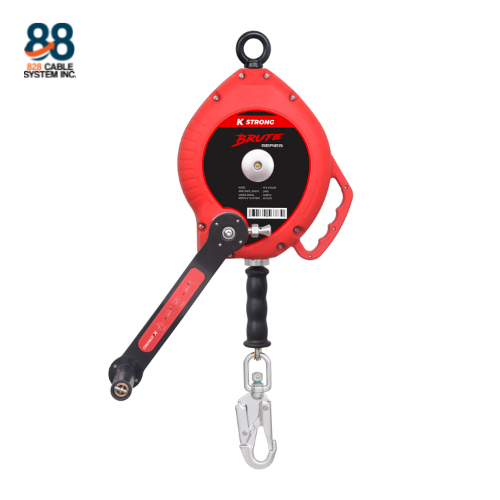
A Comprehensive Guide to Choosing the Right Self-Retracting Lanyard
When working at heights, ensuring the safety of your employees is paramount. Self-retracting lanyards (SRLs) are a critical component of fall protection systems, designed to provide reliable safety and mobility. This guide will help you navigate the process of choosing the right SRL, ensuring you select a product that meets your specific needs and safety standards.
Understanding Self-Retracting Lanyards
Self-retracting lanyards, also known as self-retracting lifelines (SRLs), are advanced fall protection devices that maintain a constant tautness while allowing users to move freely within their work area. Just like a car seatbelt, an SRL extends and retracts automatically, providing safety without hindering movement. In the event of a fall or sudden tug, a built-in braking system activates, halting further descent and reducing the impact. This mechanism spreads the fall’s energy over a shorter distance, enhancing safety and comfort.
Key Features to Consider When Choosing an SRL
Braking System: The braking system is crucial for mitigating the impact of a fall. Look for SRLs with a high-quality braking mechanism that activates promptly during a fall. A reliable braking system will ensure that the fall is stopped effectively, minimizing potential injuries.
Lanyard Length: Selecting the appropriate length of the lanyard is vital for different work environments. The length should be sufficient to allow movement while ensuring that it prevents any fall from reaching dangerous heights. Consider the vertical distance between your work platform and potential fall hazards when choosing the length.
Weight and Durability: Durability and weight are important factors. An SRL made from robust materials will last longer and provide reliable performance in demanding environments. Ensure the SRL is lightweight enough for comfort but sturdy enough to withstand the rigors of your work setting.
Housing Material: The housing of an SRL protects its internal components from damage. Common materials include aluminum and high-impact plastics. Choose a housing material that offers durability and protection against environmental conditions, such as exposure to chemicals or extreme temperatures.
Connection Points: Ensure that the SRL’s connection points are compatible with your body harness and other equipment. Proper compatibility ensures that the SRL functions correctly and integrates seamlessly with your overall fall protection system.
Certifications and Standards: Verify that the SRL complies with industry safety standards and certifications. Compliance with standards such as ANSI (American National Standards Institute) or OSHA (Occupational Safety and Health Administration) ensures that the SRL meets stringent safety and performance requirements.
Comparing SRLs to Traditional Fall Protection Lanyards
While both SRLs and traditional fall protection lanyards serve to prevent falls, there are notable differences. SRLs offer the advantage of constant tautness and automatic retraction, which minimizes slack and reduces trip hazards. In contrast, traditional lanyards may have more slack, potentially increasing the fall distance. SRLs are generally preferred for their enhanced safety features and ease of use, especially in environments where mobility and reduced fall distances are critical.
How to Properly Use a Self-Retracting Lanyard
Installation: Proper installation is essential for effective fall protection. Attach the SRL to a secure anchor point that is capable of withstanding the forces generated during a fall. Follow the manufacturer’s instructions for correct installation procedures to ensure optimal performance.
Usage Tips: When using an SRL, ensure it is properly connected to your body harness. The SRL should be positioned in a way that allows free movement while maintaining constant tautness. Regularly check the SRL during use to ensure it is functioning correctly and free of damage.
Maintenance: Routine maintenance is crucial to keep the SRL in good working condition. Inspect the SRL regularly for signs of wear, damage, or malfunction. Follow the manufacturer’s guidelines for maintenance and servicing to ensure the SRL remains effective.
Common Mistakes to Avoid: Avoid common mistakes such as using an SRL with a damaged housing or improper connection points. Do not use the SRL beyond its rated capacity or in environments for which it is not designed. Regularly review safety procedures and ensure all users are properly trained.
Selecting the Right SRL for Your Needs
Assessing Work Environment: Evaluate the specific conditions of your work environment, including height, movement, and potential fall hazards. Choose an SRL that matches these conditions to ensure adequate protection.
Budget Considerations: While cost is an important factor, prioritize quality and safety over budget. Investing in a high-quality SRL can prevent accidents and provide long-term savings by avoiding potential injuries and associated costs.
Brand and Quality: Select SRLs from reputable brands known for their reliability and safety. Research customer reviews and industry ratings to find a product that meets your expectations and provides dependable performance.
Takeaway
Choosing the right self-retracting lanyard is crucial for ensuring safety in your work environment. By considering factors such as braking systems, lanyard length, durability, and compliance with standards, you can select an SRL that offers optimal protection. Prioritize safety, and make an informed decision to safeguard your employees effectively.
